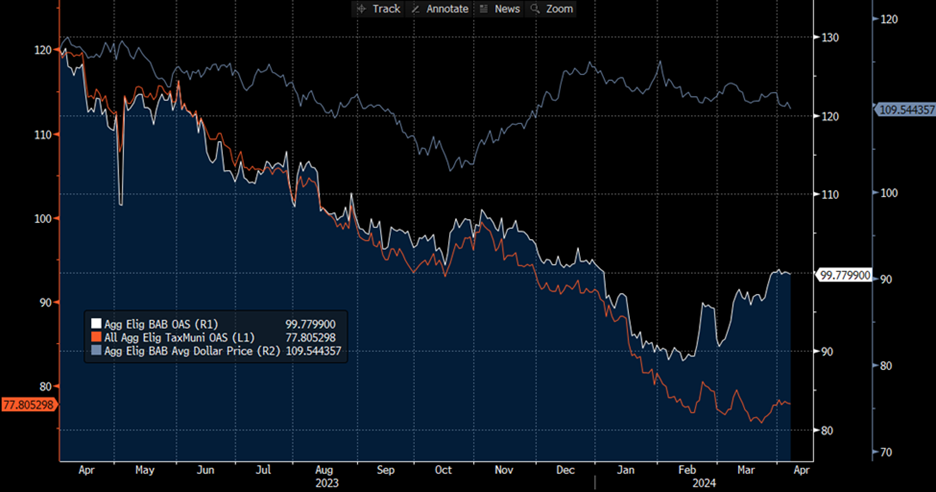Not So Extraordinary BABs
April 11, 2024
.png)
The investment grade (IG) corporate credit market has followed up the very strong performance at the end of 2023 with a slow, steady grind tighter in spreads so far in 2024. Meanwhile, the high quality Bloomberg Taxable Municipal Index has continued to outperform IG corporate credit this year on a spread and excess return basis. However, within the taxable municipal index, Build America Bonds (BABs) have recently been a notable laggard.
BABs were introduced during the Global Financial Crisis (GFC) (via the American Recovery and Reinvestment Act of 2009) as a means for issuers to access capital because the traditional tax-exempt market had essentially shut down at that time. BABs are a taxable municipal product where the federal government covers a portion of the issuer’s interest cost. The program, which was closed at the end of 2010, was a very effective tool during the GFC as it tapped a much larger and deeper investor base in taxable credit. Issuers continue to borrow in the (non-BAB) taxable municipal market, although generally in low volumes, with only about $30-$40 billion issued annually.1
Many BABs issued during the GFC contain an optional Extraordinary Redemption Provision (ERP) which would be triggered if the federal subsidy was cut. In most cases, the issuer would be eligible to redeem the bonds at the higher of par or +100 basis points (bps) spread versus comparable Treasuries. With the passing of the Budget Control Act of 2011, which went into effect in 2013, the federal subsidies were decreased as a result of automatic spending cuts (sequestration). The cuts are in effect to this day, albeit at a slightly lower level (~5%).2 This effectively made BABs with the ERPs eligible to be called since 2013.
The strong spread performance in taxable municipal bonds this year had included BABs trading through the 100 bps ERP spread. With the tax-exempt market trading at tight levels, the economics for some issuers in exercising the ERP and refinancing in the tax-exempt market has been quite compelling. As a result, there have been over 3.6 billion in bonds (year-to-date) where the ERP was exercised.3 Other issuers have announced they are considering the ERP as well — potentially another five billion bonds.
Today’s Chart of the Week highlights how the increase in ERP calls has led to Bloomberg BAB Index spreads widening to +100 bps context after being inside of 90 bps in February. As displayed in today’s chart, the average dollar price of bonds in the BAB Index is $109. In the past year, BABs have now lagged the overall Bloomberg Aggregate Eligible Taxable Municipal Index by approximately 22 bps.
Key Takeaway
Given the lack of BAB ERP calls in the past decade, many market participants viewed the possibility of any meaningful bond redemptions as unlikely, and spreads recently traded well through the ERP level. It has proven unwise to chase many BABs through the ERP as bonds have been taken out. While court challenges related to the legality of the call emerged, a federal claims court ruled that sequestration does constitute an ERP event. BABs trading through or near the ERP level seem ripe for being called, given the sizable cost savings in refinancing in the tax-exempt market.
Sources:
1,2Barclays
3J.P. Morgan
This material is for informational use only. The views expressed are those of the author, and do not necessarily reflect the views of Penn Mutual Asset Management. This material is not intended to be relied upon as a forecast, research or investment advice, and it is not a recommendation, offer or solicitation to buy or sell any securities or to adopt any investment strategy.
Opinions and statements of financial market trends that are based on current market conditions constitute judgment of the author and are subject to change without notice. The information and opinions contained in this material are derived from sources deemed to be reliable but should not be assumed to be accurate or complete. Statements that reflect projections or expectations of future financial or economic performance of the markets may be considered forward-looking statements. Actual results may differ significantly. Any forecasts contained in this material are based on various estimates and assumptions, and there can be no assurance that such estimates or assumptions will prove accurate.
Investing involves risk, including possible loss of principal. Past performance is no guarantee of future results. All information referenced in preparation of this material has been obtained from sources believed to be reliable, but accuracy and completeness are not guaranteed. There is no representation or warranty as to the accuracy of the information and Penn Mutual Asset Management shall have no liability for decisions based upon such information.
High-Yield bonds are subject to greater fluctuations in value and risk of loss of income and principal. Investing in higher yielding, lower rated corporate bonds have a greater risk of price fluctuations and loss of principal and income than U.S. Treasury bonds and bills. Government securities offer a higher degree of safety and are guaranteed as to the timely payment of principal and interest if held to maturity.
All trademarks are the property of their respective owners. This material may not be reproduced in whole or in part in any form, or referred to in any other publication, without express written permission.

